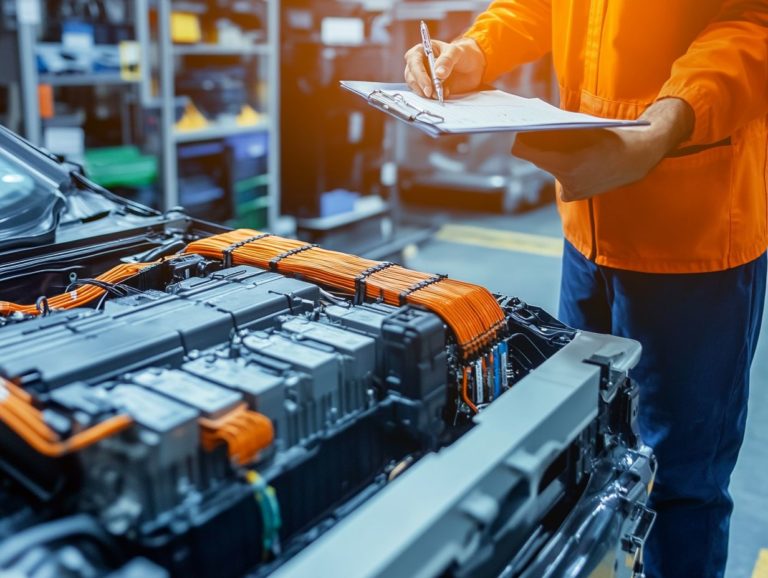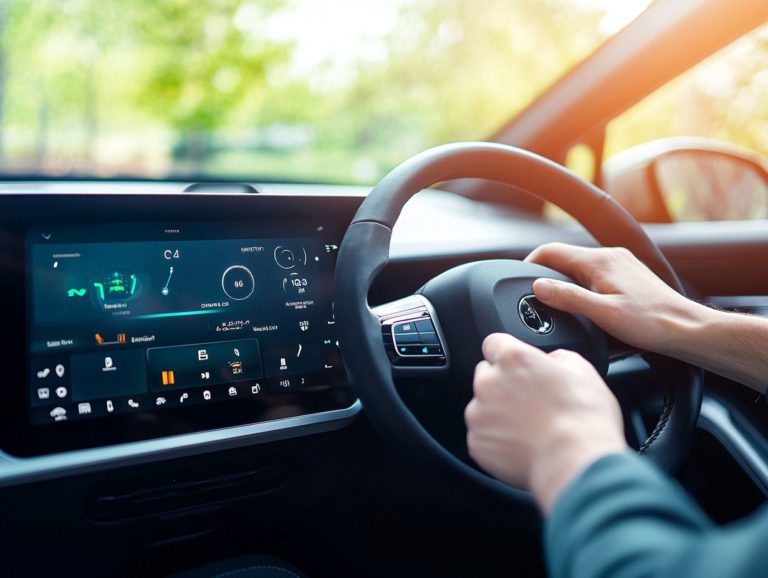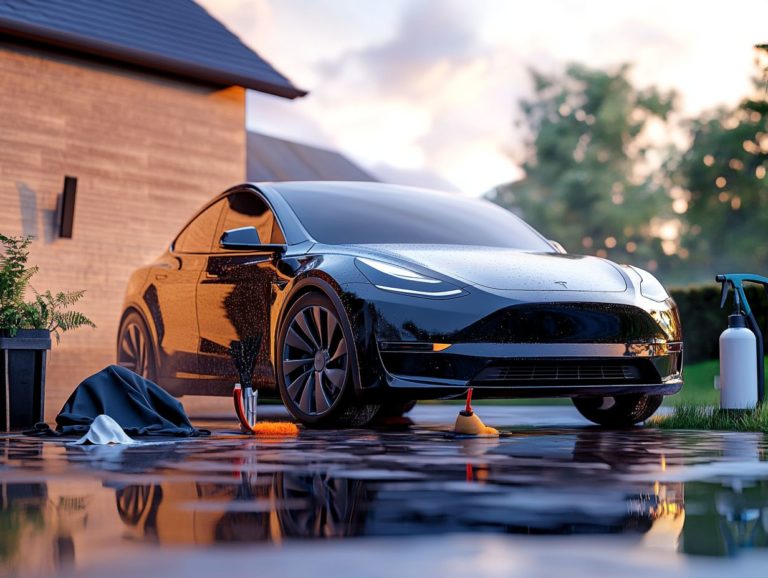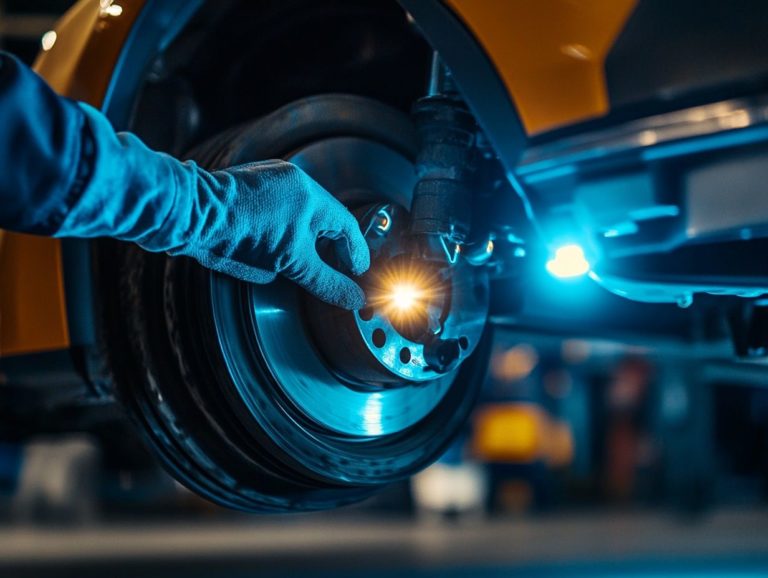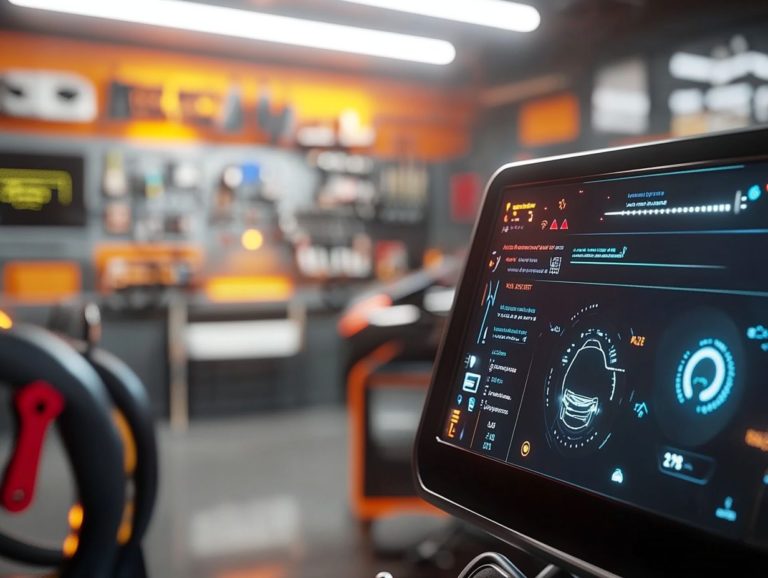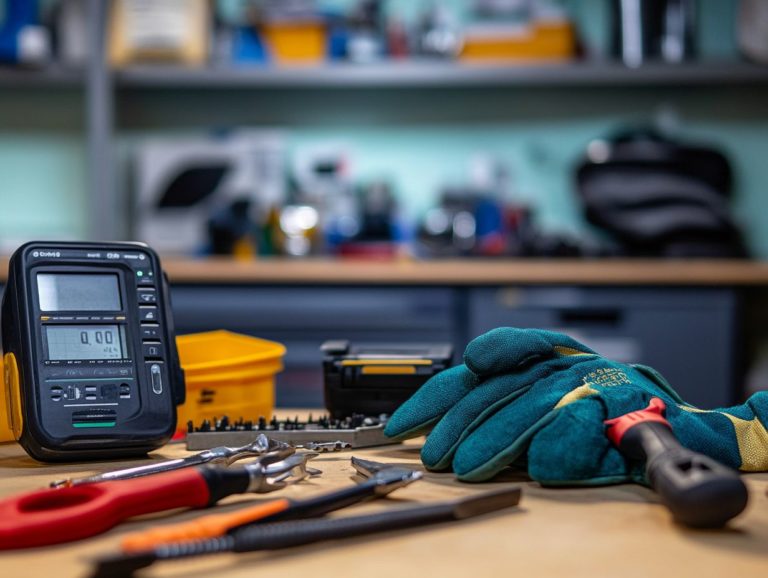How to Maintain Your EV’s Glass and Windows
Maintaining the glass and windows of your electric vehicle (EV) is essential for both aesthetics and safety. Over time, challenges such as scratches, chips, and water spots can jeopardize your visibility and detract from the sleek appearance of your ride.
This article delves into the common issues you may encounter, sharing best practices for cleaning and protecting your EV’s glass. You ll also discover valuable tips to prevent damage and learn when to tackle repairs yourself versus when to call in the professionals. Keep your EV in pristine condition and enjoy your driving experience without a hitch!
Contents
- Key Takeaways:
- The Importance of Proper Maintenance
- Common Issues with EV Glass and Windows
- Best Practices for Cleaning and Protecting EV Glass and Windows
- Preventing Damage to EV Glass and Windows
- Repairing Damaged EV Glass and Windows
- Frequently Asked Questions
- 1. How often should I clean my EV’s glass and windows?
- 2. What type of cleaner should I use on my EV’s glass and windows?
- 3. How do I prevent foggy windows in my EV?
- 4. Can I use a pressure washer to clean my EV’s windows?
- 5. How do I maintain the tint on my EV’s windows?
- 6. What should I do if my EV’s windows are stuck?
Key Takeaways:
- Regular maintenance is crucial for preserving the lifespan and appearance of your EV’s glass and windows.
- Common issues such as scratches, water spots, and stains can be prevented with proper cleaning and protection practices.
- In case of damage, consider professional services for repairing EV glass and windows to ensure safety and optimal results.
The Importance of Proper Maintenance
Proper maintenance is essential for maximizing the performance and longevity of your electric vehicle (EV), especially when it comes to the upkeep of glass and windows. This aspect is particularly important given that EVs, like the Leaf, have specific needs that set them apart from traditional internal combustion engine (ICE) vehicles.
To keep your EV in top shape, regular maintenance tasks such as tire rotations, battery changes, and coolant top-offs should go hand in hand with meticulous window care. This diligence not only prevents issues like window fogging and scratches but also ensures that your vehicle remains safe and visually appealing.
By following safety guidelines and using the right cleaning tools, you can maintain both the aesthetics and functionality of your beloved EV.
Common Issues with EV Glass and Windows
Electric vehicles, while innovative, are not exempt from the typical challenges associated with glass and windows that can greatly influence visibility and safety. You may encounter issues such as window fogging, scratches, and chips, which often arise from moisture buildup or improper cleaning techniques.
Given the insulating properties of the glass panes in EVs, it’s crucial for you to know how to tackle these concerns to preserve both clarity and how well the glass keeps heat. Recognizing the effects of humidity and temperature fluctuations on glass surfaces is essential for maintaining optimal performance.
Scratches and Chips
Scratches and chips on your EV windows can compromise not just aesthetics but also safety, ultimately shaping your perception of the vehicle’s overall quality. These imperfections can arise from various factors, including debris, improper cleaning techniques, or thermal cycling, which gradually weakens the glass structure. Addressing these issues promptly is essential for maintaining both the vehicle’s range and its appearance.
Consider the small stones and particles that kick up from the road; they can create tiny impacts that, if left unchecked, may develop into larger cracks over time. Regular maintenance is crucial. Washing your windows with suitable materials and steering clear of abrasive cleaners can significantly minimize these risks.
Implementing protective films or choosing windshield wipers specifically designed for electric vehicles can provide an extra layer of safeguarding for your glass. Exercising caution when parking in areas susceptible to falling debris or branches can help prevent unfortunate scratches and chips, ensuring your EV remains both visually appealing and safe for all passengers.
Water Spots and Stains
Water spots and stains can be quite the nuisance for electric vehicle owners. They often pop up after a rain shower or a thorough wash. These blemishes not only obscure the clarity of your windows but also detract from the sleek aesthetic of your EV.
Tackling these stains requires effective cleaning tools and solutions, like vinegar mixtures and rubbing alcohol. These can help restore your glass surfaces to their original brilliance.
To effectively combat these pesky imperfections, many find that a combination of microfiber towels and specialized glass cleaners delivers impressive results. Microfiber towels are crafted to lift dirt and grime without scratching, making them must-have tools for maintaining your vehicle’s pristine exterior.
A simple solution of equal parts vinegar and water can work wonders, breaking down mineral deposits that contribute to stubborn water stains.
For those tougher spots that refuse to budge, a gentle clay bar a special tool used to clean your car s surface can take your cleaning game to the next level. With the right techniques and products in hand, you can keep your glass surfaces sparkling clear, enhancing the overall beauty of your electric vehicle.
Best Practices for Cleaning and Protecting EV Glass and Windows
To keep your electric vehicle’s glass and windows in impeccable condition, it is essential to adopt best practices for both cleaning and protection. Utilize the right cleaning tools and techniques specifically designed for modern EVs.
Consider applying protective coatings that enhance thermal efficiency and facilitate moisture escape. Regularly inspect defrost options and address any weaknesses in seals to avoid annoying issues like foggy windows. This will help you maintain optimal visibility at all times.
Recommended Products and Techniques
Utilizing the right products and techniques can significantly elevate your cleaning process for EV windows. By incorporating these essential tools into your window cleaning routine, you can achieve a crystal-clear finish that enhances both the look and visibility.
Vinegar serves as a powerful yet gentle cleaner, effortlessly cutting through grime while remaining kind to the environment a favorite choice for eco-conscious drivers. Rubbing alcohol, on the other hand, evaporates quickly, leaving no traces behind and ensuring a streak-free shine that s perfect for bright sunny days.
Investing in specialized equipment, such as an aquarium air pump or air compressor, can help you thoroughly remove moisture, preventing dreaded water spots that can cloud your window s clarity. A spray needle is particularly beneficial, allowing you to access tight corners and crevices without risking scratches or discoloration.
Preventing Damage to EV Glass and Windows
Preventing damage to your electric vehicle’s glass and windows is crucial for both safety and preserving the vehicle s aesthetic charm.
By implementing straightforward preventive measures like monitoring temperature fluctuations and following proper cleaning techniques you can greatly reduce the risks of scratches and fogging.
Embrace a regular maintenance routine and adhere to established safety guidelines to extend the lifespan of your vehicle’s glass components. This will ensure they remain as pristine as the day you drove off the lot.
In summary, keeping your EV glass clean and protected not only enhances its appearance but also improves your overall driving experience. By following these best practices, you can enjoy a clear view and maintain the beauty of your electric vehicle.
Tips for Avoiding Common Issues
Be proactive about maintenance and cleaning! To sidestep common issues like window fogging and scratches, regularly check for any seal weaknesses and moisture build-up. Use cleaning tools specifically designed for electric vehicles. Staying informed about how glass interacts with environmental factors helps prevent damage.
When wiping the glass, use microfiber cloths to avoid tiny scratches. Steer clear of ammonia-based cleaners that can harm tints and seals. Regularly applying a high-quality glass treatment creates a protective barrier against dirt and grime, enhancing visibility and reducing cleaning frequency.
Keeping your vehicle in a shaded area or using a sunshade significantly reduces temperature fluctuations, which contribute to stress from temperature changes and potential glass cracking. Taking these proactive measures helps ensure your glass stays clear, functional, and free from issues that could detract from your driving experience.
Repairing Damaged EV Glass and Windows
For repairing damaged glass and windows on electric vehicles, you have options ranging from DIY solutions to professional services. For minor scratches, consider using specialized tools like glass drill bits to tackle the issue yourself.
However, for more significant damage, it s wise to seek the expertise of professionals who can navigate necessary safety guidelines, ensuring repairs are effective and maintain the integrity of your vehicle.
DIY Solutions vs Professional Services
Choosing between DIY solutions and professional services for repairing EV glass largely hinges on the extent of the damage and your expertise. DIY options can be an economical choice for minor repairs but may lack the precision that professionals provide. Professionals have the knowledge and tools necessary to ensure safety guidelines are rigorously adhered to.
When assessing the repairs, weigh the benefits of saving money through DIY methods against the risks of improper installation. Tackling small chips yourself may seem tempting, but it could unintentionally lead to more extensive damage if not executed properly. Conversely, opting for professional services ensures repairs are carried out swiftly and safely, alleviating concerns about long-term structural integrity.
Ultimately, your decision will depend on whether you prioritize immediate financial savings or the peace of mind that comes with expert workmanship.
Frequently Asked Questions
1. How often should I clean my EV’s glass and windows?
It is recommended to clean your EV s glass and windows at least once a week to prevent the buildup of dirt and debris. If you live in an area with heavy pollution or frequently drive on dusty roads, you may need to clean them more often.
2. What type of cleaner should I use on my EV’s glass and windows?
It is best to use a glass cleaner specifically designed for automotive use. Avoid ammonia-based cleaners as they can damage the tint on your windows and cause streaks.
3. How do I prevent foggy windows in my EV?
To prevent foggy windows, ensure the inside of your EV is clean and free of any residue or film. You can also use an anti-fogging solution or a small amount of shaving cream on a cloth to wipe down the windows.
4. Can I use a pressure washer to clean my EV’s windows?
No, it is not recommended to use a pressure washer to clean your EV s glass and windows. The high pressure can damage the seals and cause leaks. Stick to a gentle stream of water from a hose.
5. How do I maintain the tint on my EV’s windows?
To maintain the tint on your EV s windows, avoid harsh chemicals or abrasive cloths when cleaning. Tint-safe cleaners and soft microfiber cloths are best for preserving the tint.
6. What should I do if my EV’s windows are stuck?
If your windows are stuck, do not force them to go up or down as this can damage the mechanism. Try using a silicone-based lubricant on the tracks and gently wiggle the window to loosen it. If it still won t budge, take it to a professional for repair.

